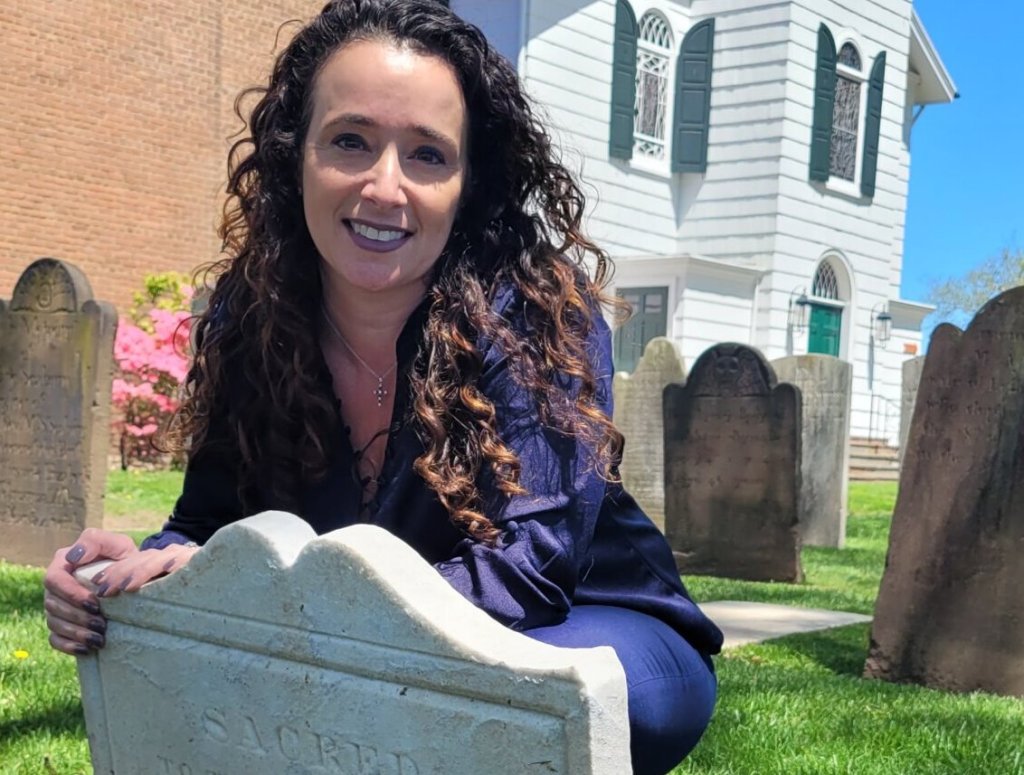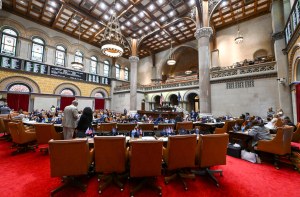A plastic bag drifts through the air as the rush of traffic on Front Street cuts through the solemnity of St. George’s Episcopal Church Cemetery. Broken beer bottles and empty chips bags clutter the grass between gravestones. Behind an obelisk, there’s an abandoned makeshift shelter made out of tattered blankets and jeans. The gravestones themselves are broken and falling, the writing barely legible.
Located in Hempstead, St. George’s Episcopal Church Cemetery seems bleak and forgotten. However, buried under discarded trash and decaying gravestones are individuals who acted as pillars of Long Island’s history. Amy Vacchio, director of Rock Hall Museum, has made it her mission to make sure these people are not forgotten.
Rock Hall Museum, located in Lawrence, is a Town of Hempstead historical landmark. Before becoming a museum, the building was home to multiple historical Long Island families.
“Built in 1767 by Josiah Martin, Rock Hall withstood the test of time through the tumultuous American Revolution, the formation of a new government and the end of slavery in New York,” reads an article titled, “The Banisters and McNeils of Rock Hall Rediscovered,” written by Vacchio and published in the Nassau County Historical Society Journal.
Throughout her years of researching the families who lived at Rock Hall, Vacchio became interested in Alice Banister McNeil, the last member of the Martin family to live in Rock Hall. After Vacchio discovered that Alice was buried at St. George’s Episcopal Church Cemetery, another important historical landmark, she decided to visit her gravestone.
However, after seeing the state of the cemetery, Vacchio decided to map and restore the entire cemetery with Matt Longo, an archivist at Rock Hall.
“The catalyst for the whole project was Alice Banister McNeil,” Vacchio said. “I just wanted to clean her gravestone because it was dirty and falling apart.”
After months of researching the church burial documents and walking around the cemetery, Vacchio and Longo created a map of where about 500 individuals were buried, citing burial sites that no longer exist because the stones deteriorated or were moved due to construction.
“There’s about 500 stones,” Vacchio said. “That’s 500 stories.”
Among these stories are those of Henry Eckford, buried in 1832, a famous shipbuilder for the U.S. Navy; Edward Greswold, buried in 1836, a lawyer who repeatedly represented Aaron Burr; James Ellsworth DeKay, buried in 1851, an American zoologist (a number of historical species were named after him); Dr. Samuel Martin, buried in 1806, who lived at Rock Hall and protested the use of the church as a granary and storage house for weapons during the Revolutionary War. And of course, the woman who inspired the unveiling of the stories of all those buried at the cemetery: Alice Banister McNeil.
“This one woman played such a significant role in the evolution of Rock Hall, from architecture to financial decisions,” Vacchio said. “Folklore tells of all those who adored her and her influence was so apparent that children were named after her.”
Alice married William McNeil in 1806 and together they had seven children. Alice died suddenly of breast cancer in December 1823. She died alone in Rock Hall since her family was in Huntsville, Alabama, investing in business ventures and building a life.
“In a sad twist of fate, probably common at the time,” Vacchio said, “Rev. Seth Hart officiated Alice’s baptism, marriage and burial.”
Following her death, William McNeil returned to Hempstead with his children and acted as the Justice of the Peace for 12 years.
“Living out the rest of his life in the Town of Hempstead, he served on various committees and boards as secretary,” reads the article written by Vacchio. “William’s prominent standing in the community is apparent in his appointment as Marshall of the Day in a 4th of July celebration held in 1837.”
William McNeil died in 1841 at the age of 56. He and Alice are now buried side by side in the cemetery.
There are hundreds of stories buried beneath the trash and broken tombstones. Vacchio emphasized the importance of uncovering those stories and restoring the resting place of all these individuals.
“That [the state of the cemetery] just broke my heart,” Vacchio said. “It’s a historical document of Hempstead and Nassau County. That land is chartered by King George, so it has British history, American history, revolutionary history, so I think it’s important for our community to take care of the history part of it.”
Within the next couple of months a sign will be installed at St. George’s cemetery with a QR code that visitors can scan and view the updated map of the cemetery. Additionally, Vacchio and Longo hope to have a cleanup day where members of the community can come and help cleanup the graveyard. They will then fundraise the money to fully restore broken and illegible gravestones.
Anyone who is interested in learning more can view the map and stories of those buried at St. George’s Episcopal Church Cemetery at historicstgeorgecemetery.org.


























